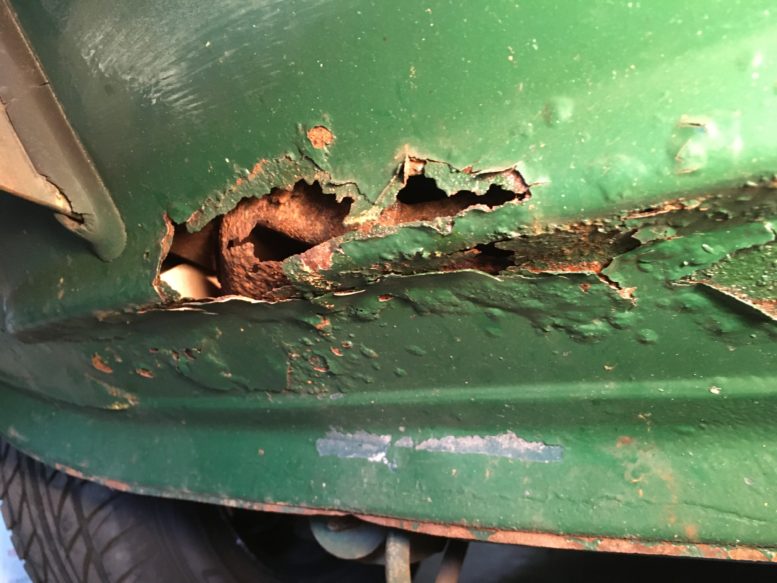My tii is rusting. Over the years, I’ve written a number of pieces addressing the issue of driving our highly rust-prone vintage BMWs. The star character in most of these has been my precious ’73 3.0CSi, since E9s are legendary rust buckets. (It was CCA member and Nor’East 02er organizer Scott Sislane who said, “Aren’t the E9’s inner fenders made from confectioner’s sugar?”)
I’ve owned the car for 34 years; it went through an outer body restoration in 1988. I can’t afford another one, and although I’ve been careful with it, it suffered through the Great Drenching Event of 2013, where on the way to the Vintage I piloted it through 500 miles of biblically drenching rain.
I’ve talked about how it doesn’t really matter if you’re in a ten-minute downpour on the way home from a Cars & Coffee meet; instead, what matters is the allocation of moisture over your lifetime of ownership of the car, and how TGDEO2013 essentially used up the E9’s lifetime allocation of moisture in one drive.
I’ve also talked about how ever since then, I’ve been hesitant to road-trip the car unless I can see a clear end-to-end forecast. For something like the Vintage, where it’s a two-day drive down, a two-day event, and a two-day drive back, you never can depend on a weather prediction.
These issues also apply to other cars. Although 2002s don’t quite have the same “they rust if you even hold a moist thought in your head” reputation as E9s, and they wear their rust on their sleeve, as opposed to hiding it in expensive-to-repair places the way E9s do, they (and most other cars built before galvanization was standard practice) are, to some extent, self-dissolving if you get them wet, particularly if there’s already exposed rust on them.
I was reminded of this as I started to engage Louie, my ’72 2002tii, regarding the removal of its cracked head. As I began discussing last week, I brought the car back from Fitchburg, tucked it away in the back corner of the garage, and planned to begin plugging away at it a little bit each night.
Last week I only got as far as jacking up the nose and setting the car on stands in preparation to undo the three 17-mm nuts to disconnect the downpipe from the exhaust manifold. While I was doing that, however, it was impossible not to notice the line of rust beneath the bumper line on the nose.
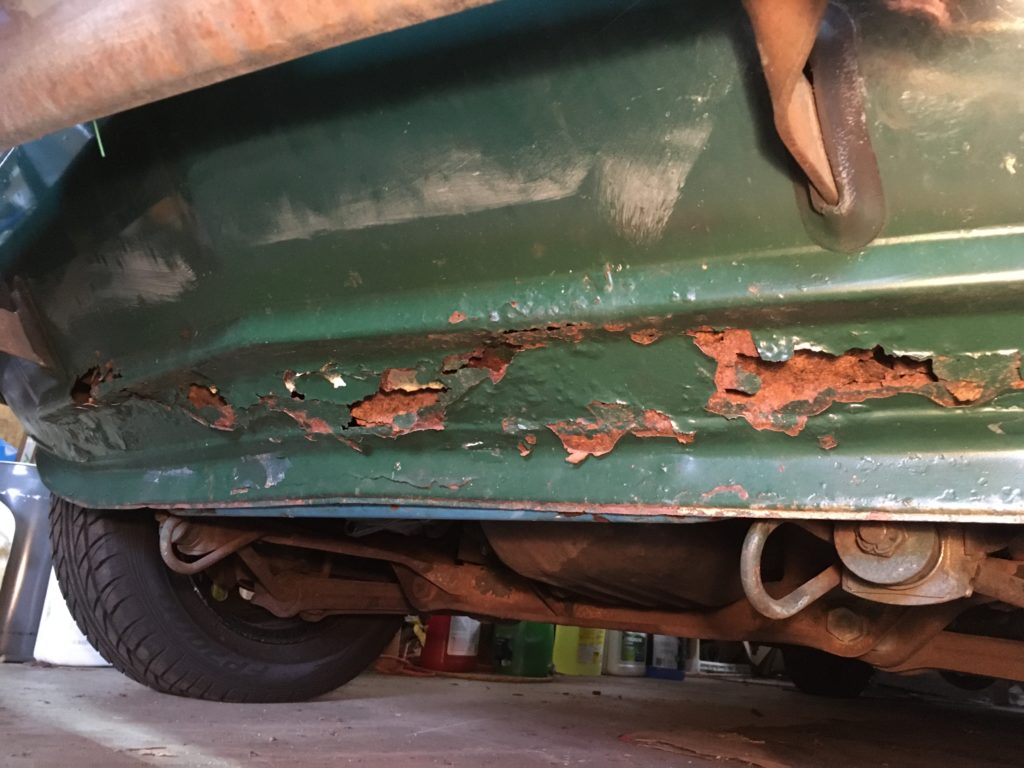
Yikes!
It’s even worse when you look at the rust perforations individually.
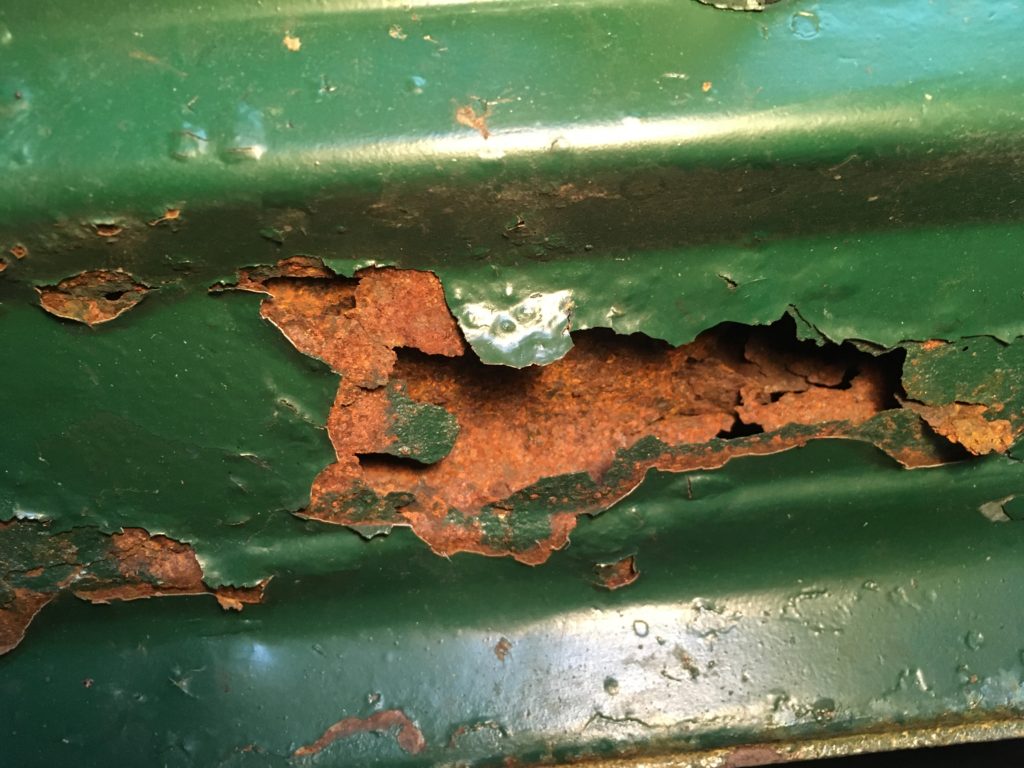
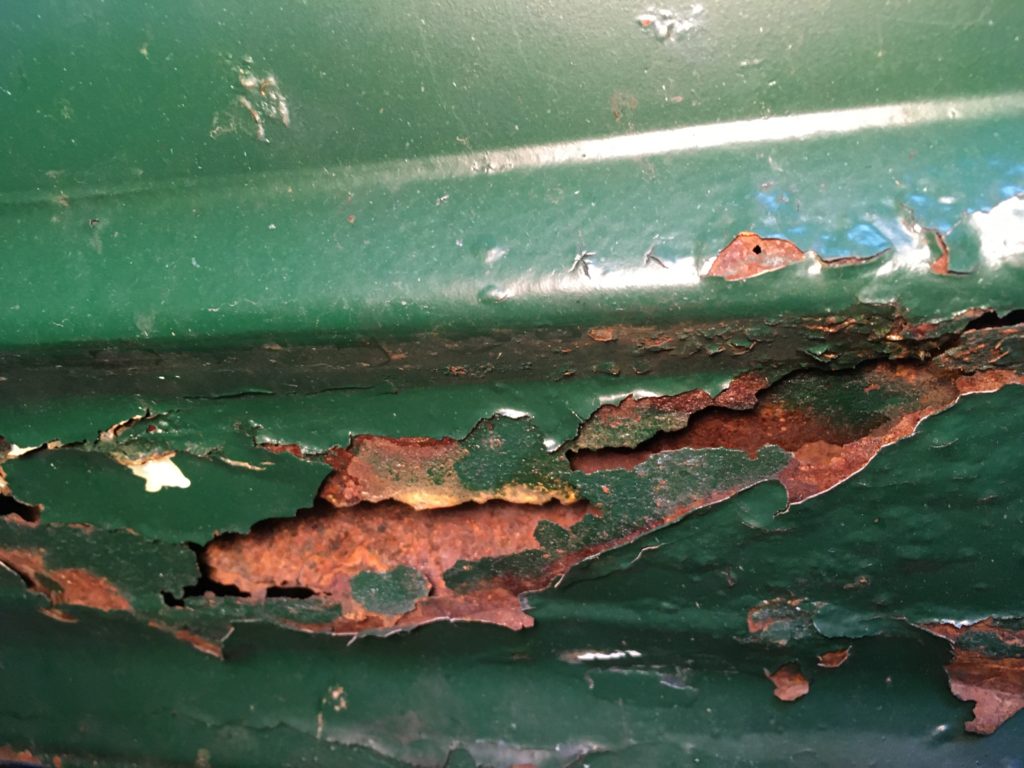
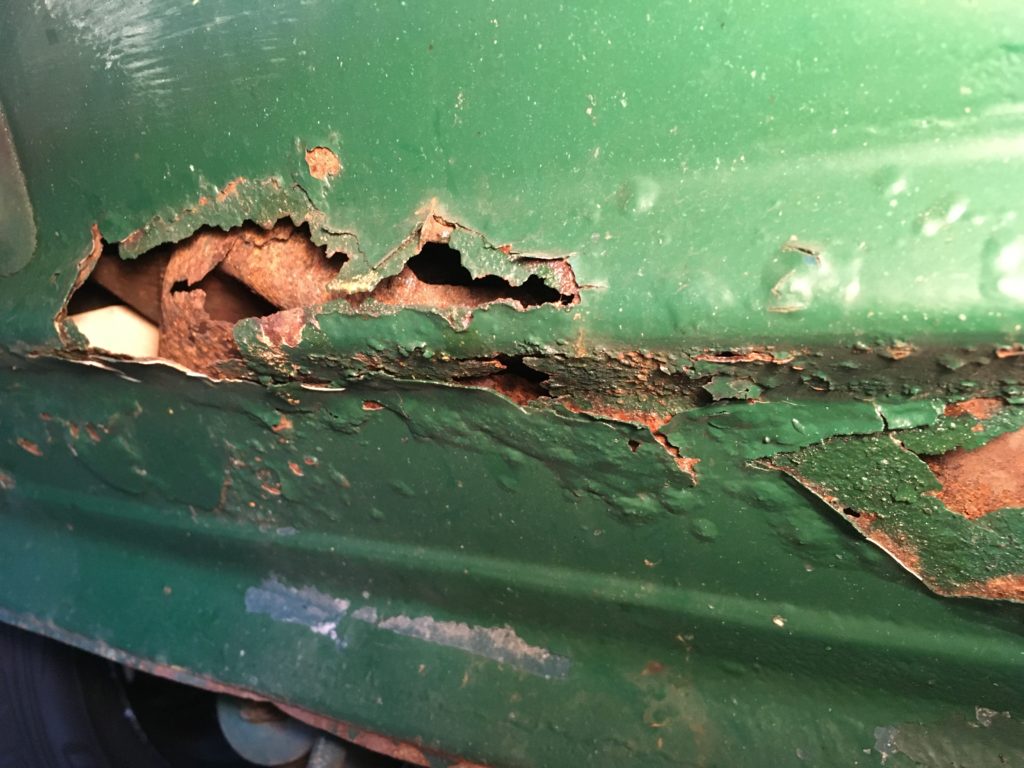
For reference, here’s how the nose of the car looked just before I bought it back in early 2017.
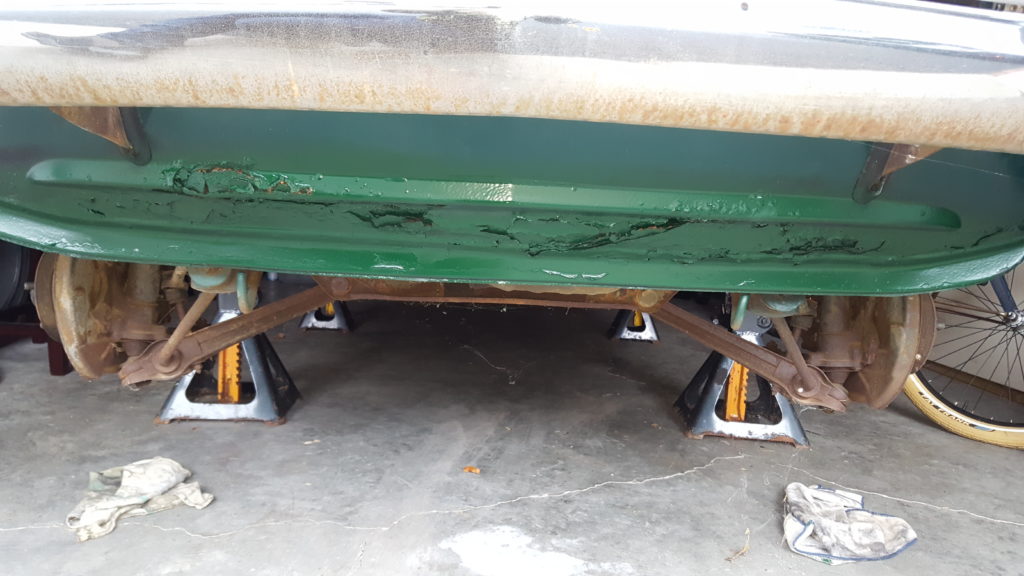
Clearly there was non-trivial rust on the nose that had simply been sprayed over when I bought the car in early 2017, but man, did it ever yawn open over the last five years!
Why? Was I careless with the car?
When I bought Louie, I already owned another ’72 tii (Kugel), which was by any objective measure a better car; Kugel was virtually rust-free; it also had a rebuilt engine and Kugelfischer pump, a five-speed, freezing a/c, a rebuilt front end, sorted suspension, freshly reupholstered E21 Recaros, and on and on. I only bought Louie because I wanted the whole Ran When Parked adventure of buying a dead car sight-unseen, swooping in with tools and parts, reviving it where it sat, and road-tripping it home.
As part of that undertaking, I worked in Jake and Liz Metz’ pole barn in Louisville, slept in their spare bedroom for nearly a week, and had other wonderful BMW folk save my butt as things went wrong. The adventure was fabulous, and since the car was the enabler of the adventure, I bonded with it to the point where when money got tight a few years back and something had to give, I didn’t need two 1972 2002tiis, and it was Kugel that went on the block, not Louie.
While I can’t say that I regret the decision, it’s also fair to say that I didn’t knowingly set myself on a path where I now own a tii to which the adjective rusty applies more than I’d like, and whose outer-body repair costs are probably more than I can shoulder.
I think that cars, particularly vintage cars, fall into three broad categories: There are rust-free cars in excellent condition that you try as hard as possible to keep that way. For me, that includes actively avoiding driving them in the rain (and I have mad respect for my friends who are more life is short I’m gonna DRIVE this thing than I am).
There are “driver-quality” classics that have that name because you’re less worried about getting them wet or scratched, but that doesn’t mean that you’re going to take them into a snowy salty parking lot and do donuts, either.
And then there are cars to which you do exactly that. Well, maybe not the actual donuts (okay, maybe the actual donuts), but you drive them in all sorts of weather, including snow. This could be because they’re simply your four-season daily driver, or because the car is a designated winter beater. Back in the day, I certainly had winter-beater 2002s (hell, one season I even prepared a rusty winter-beater 2800CS, putting snows on all four corners, until the City of Boston got wise to the fact that it was unregistered, towed it, and crushed it). But that was when they were just ten-year-old used cars, not acknowledged valuable classics.
Even though Louie was a car with patina and that rust in the nose, when I bought it, it was in general a very solid car. It had zero holes in the frame rails, floor, or shock towers, and just one rust blister on one of the rocker panels. So I’ve never come anywhere close to treating it as if it’s a winter beater.
Still, rewinding the tape and looking at the evidence, I did purchase the car during the winter of 2017, and when I revived it and drove it home, although it was a warm spell, it was late February, and that’s very much winter. Plus, it rained during most of the thousand-mile drive home from Louisville to Boston. I vividly remember this because the car’s hardened and shriveled windshield gasket passed water like a sieve, so much of it that it literally puddled on top of the rugs.
With likely pre-treated roads followed by rain, who knows how much salty water got kicked up onto the bottom of the car, including that pre-existing rust in the nose? And, in addition to the nose, checking that rocker panel, I can see that the “one rust blister” has spread as well.

Totally not kidding about the standing water.
Then Louie had further exposure. The following spring I drove it to the Vintage and back, and when the car was accepted into the “2002 Icon” exhibit at the BMW CCA Foundation, I drove it to Greer, South Carolina. I just checked the date: February 2018. Photos of the trip do show a certain amount of rain.
At the time, I didn’t view any of this as an act of violence against the car, but I can now appreciate that these three successive thousand-mile trips, two of them in winter, were likely not without rust-spreading consequence.
Over the summer—well before last week, when I fully looked this rust nose monster in the face—I received an email from Maximillian Importing Co. about their just-back-in-stock 2002 nose panels. The noses were on sale: $990 marked down to $675 shipped. I remember going to their website, seeing that they had all four nose styles (meaning early and late, snorkel (carbureted) and non-snorkel (tii)) and thinking, “Damn, that’s a good price—I should buy an early tii nose for whenever I get the money to do Louie.”
However, I recalled hearing some scuttlebutt that the no-snorkel tii nose wasn’t quite right. I posted the question to bmw2002faq, and someone responded with a video that showed that there was an incorrect indentation on the no-snorkel nose in the location where the snorkel would be. I balked and didn’t complete the transaction. (In fairness to Maximillian, I don’t know whether or not this was a defect in an early production run and has since been corrected. Please don’t let this info sway you one way or the other. Contact Maximillian directly if you’re interested in a tii nose.)
I just checked the Maximillian website. The price is back up to $990, and early noses, snorkel or no, are no longer in stock. Woulda, coulda, shoulda.
It occurs to me that the three 2002s I currently own could be construed as falling flawlessly into the three categories I described earlier. Hampton, the nearly rust-free 49,000-mile survivor car, is the one I go to great lengths to keep dry (although yes, as I described last week, I did run the car out to Fitchburg after the roads had been treated, although it wasn’t rock salt, the roads were dry, and I didn’t see any visible evidence that anything was being kicked up).
Louie is the “driver-quality” car.
Bertha, the ’75 2002 that I drove off from my wedding in in 1984 and eventually converted into a track rat, sold, and bought back in horrible condition 26 years later, certainly looks like the kind of car I’d use to do donuts in salty, slushy parking lots, but that’s not the case at all. I’m hyper-aware that because of its rusty patina, the rust will positively explode if I do the screw-it-I-don’t-care-what-happens-to-it thing. Plus, it’s got a hand-size rust hole in the floor that’s uncomfortably close to one of the transmission mounting bracket tabs.
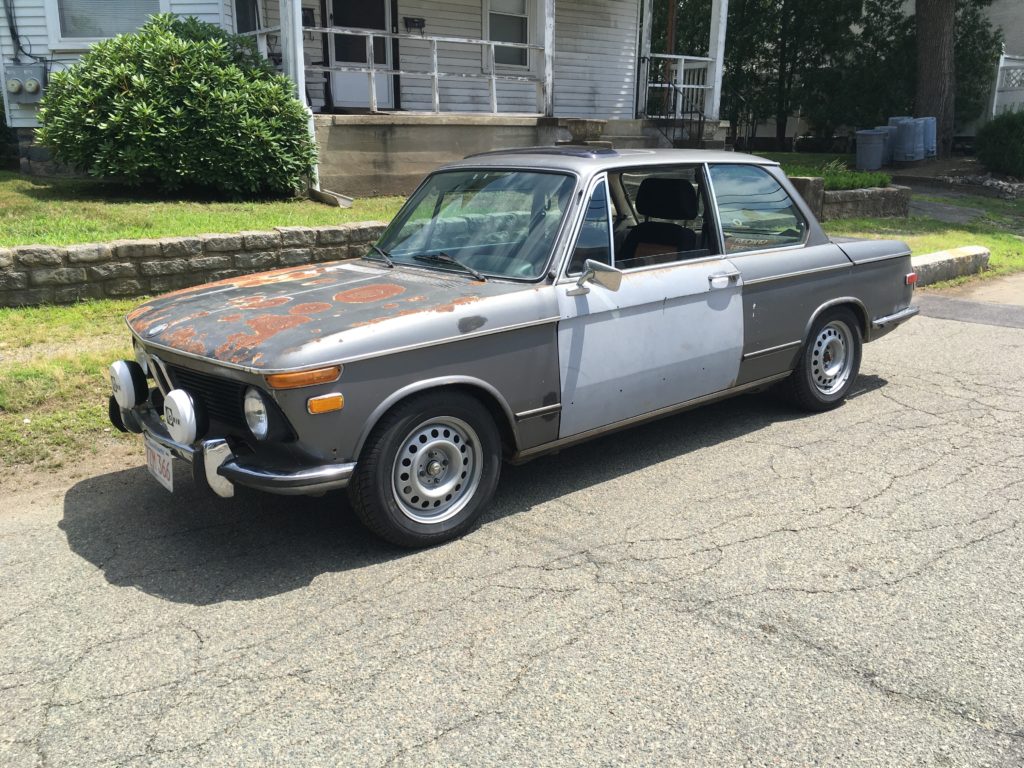
You’d think that I winter-hoon this, but I don’t.
Looking back on it, I can’t say that if I had to do it again, I’d use Louie a different way. I bought it when it became available. I drove down in February in the rented SUV with tools and parts because there was a ten-day forecast that showed unusually mild weather across a broad swath of the East Coast. I didn’t even remotely consider having the car shipped home instead, since that would’ve removed the whole Hack-Mechanic-Versus-The-Machine adventure thing that I wanted.
Likewise, when the car was accepted into the “2002 Icon” exhibit, its acceptance was precisely because the car wasn’t a beautifully restored trust-fund child like most of the others. Instead, its roughness was a manifestation of the fact that the car was something of a vector for BMW-related community. Unless having it shipped down to the Foundation was necessary due to a blizzard (and it wasn’t), shipping it was totally antithetical to both who I am and what the car is.
But actions have consequences. Most of the time, in situations like this, I’d give a resolute, “I can live with that.” This time, however, I’m giving a fatalistic and resigned, “I guess I’m going to have to live with that.”
Keep ’em dry, folks.—Rob Siegel
Rob’s new book, The Best of The Hack Mechanic, is available here on Amazon, as are his seven other books. Signed copies can be ordered directly from Rob here. Plus, five of Rob’s books are on sale for the holidays (cheaper from him than through Amazon).

